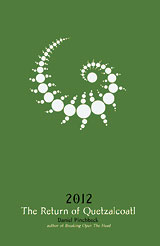It is generally regarded as a truism that there are no believers more devout than the converted — perhaps because those willing to throw over everything they once believed are ready to believe pretty much anything.
 |
Author Daniel Pinchbeck, who will bring his Mayan medicine show to Malaprop’s Bookstore this week, is no exception. The buzz surrounding Pinchbeck’s latest tome, 2012: The Return of Quetzalcoatl (Tarcher/Penguin, 2006), suggests that Asheville is infrequently exposed to such grand-scale mythologizing. Or at least not since May, when Dr. Steven Greer explained that alien perpetual-motion machines have been squirreled away by Big Oil and the CIA.
Pinchbeck has consumed considerable quantities of hallucinogenic drugs, and has decided that the Mayan calendar, whose current cycle ends in 2012, nailed it. Planetary civilization is headed for a cliff and there’s nothing to be done except to tune in and turn on.
It is considered bad form to inject oneself into reporting, but in this case it really cannot be helped. When this writer pursued a similar line of research circa 1970, the result was identical. Armageddon appeared imminent, but soon proved immanent. It may have been the end of the world as I knew it, but, to further crib from the song, “I felt fine.”
That is to say, the heavens didn’t come crashing down in 1973. Correct me if I’m wrong.
To be fair to Pinchbeck, he is considerably more articulate than Greer, but there the difference ends. He loops together crop circles, myth, environmental crisis, personal biography, the Holocaust and Nazism, Stonehenge, the Hopi calendar … and, ever au courant, 9-11 … to create a theory of everything. Except that “theory” is a bit generous, taken in its sense of a testable hypothesis. A more honest approximation would be to say that he spins a yarn.
Pinchbeck is given to lofty, unsupported statements: “September 11 was the first event to be witnessed in real time, by billions of people across the planet.” Oh? Says who? Since the text is entirely undocumented, it is impossible to ascertain where he picked up the idea that everyone was watching TV when the jets hit the towers — but, like much of the rest of this book, it fails the stink test. On the one hand, online encyclopedias report that billions have watched sporting events worldwide since sometime in the 1990s, and on the other, how many people were actually watching live coverage of the World Trade Center on that particular Tuesday morning?
George W. Bush later claimed to have seen the planes hit the towers in real time, but that doesn’t make it so.
Echoing my own experience with hallucinogens, Pinchbeck discovers threads of his own biography everywhere he goes. At Stonehenge he finds that “the primordial forms in my father’s late paintings resembled those rough-hewn boulders …” and informs his readers, “I had strong associations with it.” Same thing happened to me, Danny Boy. And the point is?
The author notes that the planetoid Sedna, discovered in 2003, “is currently making its closest approach to the earth in the last ten thousand years.” Sedna, which orbits way out beyond Pluto, was named for an Inuit goddess whose myth involves the empowerment of a woman formerly regarded as chattel. Pinchbeck invokes that naming decision to suggest some cosmic connection with the improving status of women in some parts of the world. He somehow left out the discovery by researchers at the Gemini Observatory (which discovered and named the planetoid) that Sedna is covered in a tar-like substance. There is an all-too-obvious connection to Peak Oil and the war in Iraq, not to mention Uncle Remus and the stuff that sticks to your feet on Daytona Beach.
Back in the day (1973), it was the Comet Kohoutek whose near approach was sure to change heaven and earth.
Following a successful early career as a magazine writer and a spiritual crisis that led him to ingestion of diverse alkaloidal substances, Pinchbeck has staked his job prospects on exploration of their mind-bending effects. His previous book, Breaking Open the Head: A Psychedelic Journey Into the Heart of Contemporary Shamanism (Broadway Books, 2002), received mixed reviews but established his reputation as an investigator of consciousness. Many readers will doubtless find strong associations with the new book, but as with psilocybin, peyote, ayahuasca, LSD and other mind-altering drugs, the effect is apt to be disappointingly brief.
Daniel Pinchbeck discusses his new book, 2012: Return of the Quetzalcoatl, at 7 p.m. Thursday, July 20, at Malaprop’s Bookstore (55 Haywood St.). Free. 254-6734.



Before you comment
The comments section is here to provide a platform for civil dialogue on the issues we face together as a local community. Xpress is committed to offering this platform for all voices, but when the tone of the discussion gets nasty or strays off topic, we believe many people choose not to participate. Xpress editors are determined to moderate comments to ensure a constructive interchange is maintained. All comments judged not to be in keeping with the spirit of civil discourse will be removed and repeat violators will be banned. See here for our terms of service. Thank you for being part of this effort to promote respectful discussion.